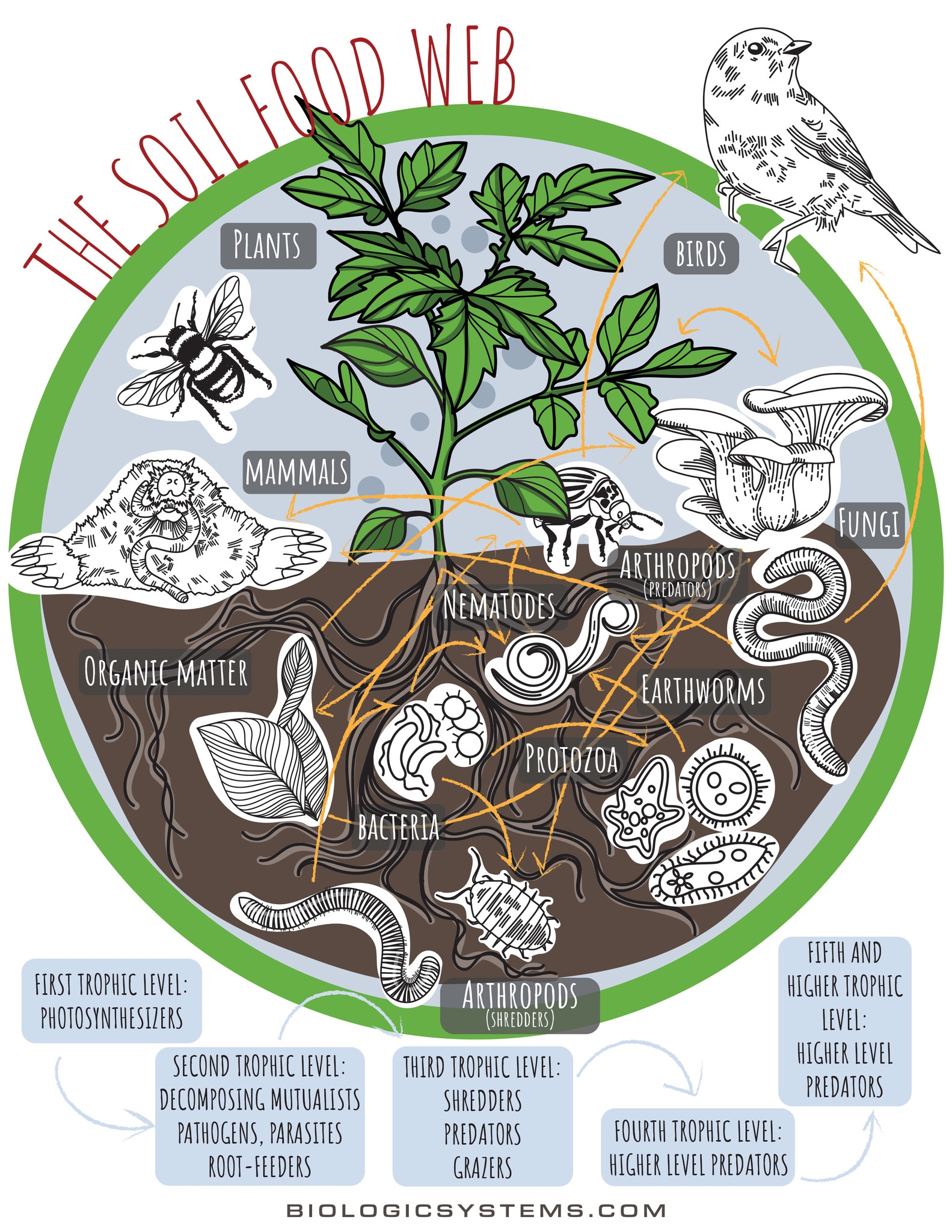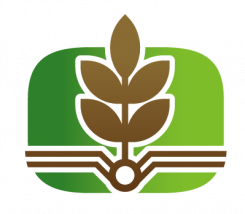Understanding The Soil Food Web
- Posted on
- By The Biologic Team

The Soil Food Web refers to the network of creatures, including insects, earthworms and microscopic organisms such as bacteria, fungi and nematodes, that inhabit and sustain the living soil beneath our feet. Together, these organisms break down organic matter and release nutrients in plant available forms in exchange for “exudates” (carbohydrates, simple sugars, and proteins) produced by plants. A healthy Soil Food Web can provide plants with all the nutrients they need plus added benefits such as improved soil structure and water-holding capacity resulting in protection from ecological threats such as drought and flooding.
The Soil Food Web Community:
Bacteria. These simple, single-celled microorganisms can be found in abundance in soil. While some pathogenic bacteria can cause disease, bacteria that improve soil quality play a fundamental role in breaking down organic material. In addition to providing essential nutrients, beneficial bacteria enhance soil structure, compete with disease-causing organisms and filter soil pollutants.
Fungi. This diverse group of multi-celled organisms best known as mushrooms, yeasts, and molds, also play a critical role in soil decomposition. While bacteria feed primarily on simple organic compounds, fungi can process more fibrous plant material and often initiate the decomposition process by softening organic debris. Of the many beneficial forms of fungi, Mycorrhizal fungi are particularly important as they form symbiotic associations with nearly all types of plant roots, greatly increasing root reach and nutrient uptake.
Protozoa. Another group of microscopic, single-celled organisms called protozoa feed primarily on bacteria, fungi and other protozoa. These “secondary” consumers release essential stores of nitrogen as a by-product of their bacteria-rich diet.
Nematodes: Like protozoa, nematodes feed on other microscopic organisms and mineralize the soil with their waste. Nematodes are multicellular, unsegmented round worms that live in water films around soil particles. Most species are beneficial, helping with the breakdown of organic residue but some act as vectors for parasitic fungi and bacteria.
Earthworms: Earthworms play an essential role in the Soil Food Web, improving soil fertility and aeration. Earthworms process organic material, minerals, bacteria, and enzymes in their digestive tract producing “castings” rich in available plant nutrients such as nitrogen, calcium, magnesium and phosphorous. Through their constant burrowing, worms create a network of channels that allow water and nutrients to permeate the soil. By aerating and mixing the soil, worms also aid root development and by extension, plant health.
Insects and Small Animals: Soil-dwelling insects range from microscopic mites to spiders and scorpions measuring several inches in length. These small animals improve soil quality by burrowing, processing organic matter and preying on harmful pests. Soil arthropods can be shredders (millipedes, sowbugs, etc.), predators (spiders, scorpions, pseudoscorpions, centipedes, and predatory mites, ants, and beetles), herbivores (symphylans, root-maggots, etc.), or fungal-feeders (springtails and turtle mites).
Large Soil Animals: Animals, such as moles, rabbits, woodchucks, snakes, prairie dogs and badgers, spend at least some of their lives below ground burrowing and consuming smaller insects and earthworms.
Soil Food Web Structure:
All the organisms in the Soil Food Web can be grouped into categories based on their position in the food chain or “trophic level”. The first trophic level is made up of organisms that photosynthesize or convert the sun’s energy into carbon and organic compounds found in plant material. Members of the second trophic level (decomposers such as bacteria and fungi) break down and process the active organic matter generated by the photoautotrophs to create additional available nutrients. Shreders, predators and grazers such as protozoa, nematodes, and arthropods in the third tropic level feed on second trophic level organisms and larger animals in the fourth and fifth trophic levels consume the lower-level creatures.
Preserving the Soil Food Web:
Just as a diverse and abundant population of soil organisms results in healthy soil and productive crops, unbalanced and deficient soil can cause disease, pest infestations and profit loss. Soil management can have a dramatic effect on the composition and health of soil biology. Tillage disturbs the larger microorganisms such as fungi and protozoa, leaving the soil without available nutrients and protection from disease. By employing a few simple practices such as adding organic material, watering wisely, protecting topsoil and rotating crops, growers can forego pricy and harmful pesticide, fungicide and herbicide applications and tap into the Soil Food Web’s potential.
Related Content:
6 Tips for Building Living Soil
Soil Microbes: Nature’s Invisible Workforce
Resources:
Catherine Moravec, et al. “The Living Soil” https://cmg.extension.colostate.edu/Gardennotes/212.pdf
Diane Miessler. “The Soil Food Web: A Gardener’s Best Friend”. https://www.storey.com/article/soil-food-web/
Fred Magdoff, Harold van Es, “Building Soils for Better Crops
Ch 4. The Living Soil”. https://www.sare.org/publications/building-soils-for-better-crops/the-living-soil/
The Soil Food Web. Soilfoodweb.com. https://www.soilfoodweb.com/resources/animations-videos/?vID=372925873&h=707aa77aa3
Vinayak Shedekar. “The Soil Food Web”. https://agcrops.osu.edu/newsletter/corn-newsletter/2019-11/soil-food-web
